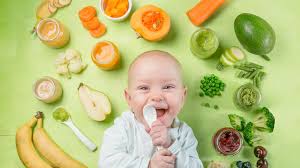
Welcome to the realm of first foods – a beckoning milestone for infants adn parents alike! Embark on a culinary adventure as we unravel the intricacies of introducing solid foods to your precious little one. This definitive guide will illuminate when and how to initiate this nourishing transition, ensuring a smooth and enjoyable experience for both you and your baby.
– Cueing Your Little Foodie: signs of Readiness for Solid Starts
Cueing Your Little Foodie: Signs of Readiness for Solid Starts
Tracking the subtle signals from your little one is crucial to determining their readiness for solids. Observe for the following cues: sitting upright with minimal support, exhibiting good head and neck control, developing the ability to bring objects to their mouth, and showing an increased interest in what caregivers are eating.additionally, pay attention to their hunger cues and ensure they’re not exclusively breast or formula-fed. Consulting with a healthcare professional is always recommended to ensure your infant is physiologically ready for solid foods.
– The Right Time,the Right Way: A Journey of Discovery
First Foods. When And How To Start Feeding Your Infant Solid Foods
The American Academy of Pediatrics (AAP) recommends that you start feeding your baby solid foods around 4 to 6 months of age. This is the time when your baby has developed the physical and neurological skills needed to eat solids. By introducing solid foods at this time, you can definitely help your baby develop healthy eating habits and prevent food allergies.
Here are some signs that your baby may be ready for solid foods:
They can hold their head up.
They can sit upright with support.
They have lost the tongue-thrust reflex.
They are interested in what you are eating.
They are opening their mouth when you offer them food.
If you are not sure if your baby is ready for solid foods, talk to your pediatrician.
When you start feeding your baby solid foods, it is indeed crucial to do it slowly and gradually. start by offering your baby a small amount of pureed food once or twice a day. As your baby gets used to eating solids, you can gradually increase the amount and frequency of feedings.
Here are some tips for feeding your baby solid foods:
Start with soft, single-ingredient foods. This will help your baby get used to the taste and texture of solid foods.
Mash or puree foods until they are smooth. This will make it easier for your baby to swallow. Do not add salt, sugar, or other seasonings to your baby’s food. Their kidneys are not yet developed enough to handle these additives. Be patient. It may take your baby some time to get used to eating solid foods. Do not force them to eat if they are not interested.
Watch for signs of allergies. If your baby develops a rash, hives, or vomiting after eating a new food, stop feeding them that food and call your pediatrician.
Introducing New Foods
Once your baby has gotten used to eating pureed foods,you can start introducing them to new foods. Here is a general timeline for introducing new foods:
4-6 months
Start with soft, single-ingredient foods. This will help your baby get used to the taste and texture of solid foods.
Good choices include: rice cereal, oatmeal, mashed avocado, banana, sweet potato, and pureed fruits and vegetables.6-8 months
Continue offering pureed foods.
You can start to add more variety to your baby’s diet. This includes foods like yogurt, cheese, and beans.
You can also start offering your baby finger foods. This will help them develop their pincer grasp and hand-eye coordination.
9-12 months
Your baby should be eating a variety of foods from all food groups.
You can continue to offer your baby finger foods.
You can start to introduce more table foods. This includes foods like chicken, fish, pasta, and bread.
12+ months
Your baby should be eating a variety of foods from all food groups.
They should be able to eat most of the same foods that you eat.
* You should continue to offer your baby healthy snacks and meals.
Remember to talk to your pediatrician about your baby’s specific nutritional needs.
– Puree to Paste: Navigating Food Textures for Tiny Tummies
Puree to Paste: Navigating Food Textures for Tiny Tummies
As your little one transitions from liquids to solids, it’s essential to introduce them to varying food textures gradually. start with smooth purees that are easily digested and gradually increase the texture as their teeth erupt and their chewing skills develop. Here’s a guide to mastering this transition seamlessly:
- Pureed: The smoothest texture for infants, made by blending cooked fruits, vegetables, or meats until completely smooth and liquid.
- Mash: Slightly thicker than purees,mashed foods still have a soft consistency that’s easy for babies to manage.
- Fortified Finger Foods: Around 8-10 months, introduce soft, finger-shaped foods that encourage self-feeding and growth of fine motor skills.
- soft and Small pieces: As toddlers grow, introduce small, age-appropriate pieces of soft foods, such as ripe fruits, steamed vegetables, and cooked pasta.
- Chewy: once toddlers are pleasant with soft foods, gradually introduce softer chewy foods such as cooked lentils, beans, and soft-rind cheese.
– Mealtime Mastery: Establishing Healthy Habits from the Start
When to Introduce Solids
Generally, the American Academy of Pediatrics (AAP) recommends starting solids around 4 to 6 months of age, once your baby:
- Can sit up with support.
- Shows an interest in food.
- Grabs at your plate or spoon.
-Opens their mouth when you offer them food.
Closing Remarks
as the journey of solid foods concludes, we wish you and your little one a world of bountiful flavors and joyful feeding moments. Remember, every baby is unique, so trust your instincts and consult with your healthcare provider to tailor your approach. With patience, consistency, and a dash of culinary curiosity, you’ll navigate this milestone together, fostering a lifelong love for wholesome nutrition and the joy of sharing meals. bon appétit!

Leave a Reply